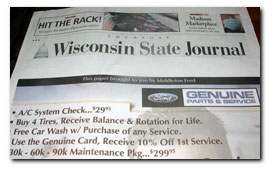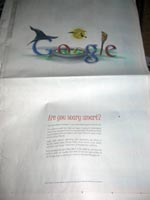Marketing is not a do-it-to-the-customer, one-way process. The highest aim of marketing is to create products and stories about them that empower customers to sell for you. Don’t simply create loyal customers. Create customers who are enraptured with your product and sell for you. Turn customers on so they will turn others into customers.
Think of eBay conclaves where loyal users tell eBay CEO Meg Whitman how to run the company and what acquisitions to make. Hark back to 1984 and the launch of Apple’s Macintosh computer. Think of all those Mac users who tried to convert you to their form of technology.
Category: Advertising
Roof Ads
Some commercial outfits are painting giant ads on their roofs for the benefit of the aerial/satellite photos used by services like Google Earth/Google Maps.
Makers Mark Marketing
For our latest podcast, we spent some time with Maker’s Mark CEO Bill Samuels Jr., who described how one rather influential person helped launched the bourbon manufacturer into the stratosphere of recognition.
He also discusses the rationale and practice of “marketing without fingerprints” and the rapid growth of its ambassador community.
Kinsley on the Future of Newspapers: Black and White and Dead All Over
And so, at last, there are two piles of paper: a short one of stuff to read, and a tall one of stuff to throw away. Unfortunately, many people are taking the logic of this process one step further. Instead of buying a paper in order to throw most of it away, they are not buying it in the first place.
No one knows how all this will play out. But it is hard to believe that there will be room in the economy for delivering news by the Rube Goldberg process described above. That doesn’t mean newspapers are toast. After all, they’ve got the brand names. You gotta trust something called the “Post-Intelligencer” more than something called “Yahoo” or “Google,” don’t you? No, seriously, don’t you? Okay, how old did you say you are?
Advertising Strategies Challenged in the High-Tech Age
NPR:
2006 is expected to be a challenging year for the advertising industry. Dollars continue to flow out of television budgets and into Internet ads. And viewers have more ways to skip commercials. With TiVos and iPods giving consumers more power, what’s an ad guy to do?
Weighty Marketing Matters
During the past month, I received 14 pounds of catalogs in the mail. That’s roughly a half-pound per day.
I didn’t ask to receive any of them, either, a claim my postal carrier could hardly be blamed to question.
Yet companies well-known, and some of them not, sent me at least one, sometimes two, three or more catalogs between Nov. 21 and Dec. 22, 2005.
Advertising & News
Kristian Knutsen nicely rounds up commentary on the recent WIBA/Amcore newsroom sponsorship deal:
his is the third part of an extended look at the deal between Clear Channel Madison and AMCORE Bank to sponsor the WIBA-AM (1310) newsroom. The first part examined the deal and the possibility that similar sponsorships of other Clear Channel newsrooms are in the offing, while part two looked at how the deal could affect WIBA’s reputation.
Selling the News: Advertising, WIBA and Local Newspapers

WIBA is receiving some grief from the Capital Times (part of the $120M advertising enterprise that is Capital Newspapers) over the sale of naming rights to its newsroom to Amcore Bank.
The agreements reflect the proliferation of corporate sponsorships in recent years — think FedEx Field and MCI Center — and the pressure many newsrooms feel to boost revenue. Close alliances between companies and news enterprises, however, raise a special set of issues related to journalistic integrity, ethicists say.
With journalism still under a cloud from some high-profile scandals, newsrooms must go to the greatest lengths to convince the public of their independence and credibility, said Kelly McBride, a journalism ethics expert at the Poynter Institute for Media Studies, a journalism training center.
“This undermines all the efforts we’re making to protect our credibility,” she said. “It creates the perception that the newsroom is for sale to the highest bidder.”
An informed society must understand that advertising, sponsorship or underwriting will always include influence. The real solution, from my perspective, is the ongoing disaggregation of media, with many, many more choices and a number of aggregators.
I wonder how sponsorship of a newsroom is any different than wrapping the daily newspaper in a sponsor’s first thing visible full page ad? See a local example here.
Tea Leaves: Google & Madison Ave: Quid Pro Quo on Advertising?
 |
 |
| Click to view a larger version of each image. | |
Not content to just suck advertising dollars from Web search, Google is using its windfall to pay for an eclectic range of ambitious projects that have the potential to radically disrupt other industries. Among other things, it is offering to build a free wireless Internet network in San Francisco, plans to scan nearly every book published and is testing a free classified advertising system it calls Google Base.
More quietly, Google is also preparing to disrupt the advertising business itself, by replacing creative salesmanship with cold number-crunching. Its premise so far is that advertising is most effective when seen only by people who are interested in what’s for sale, based on what they are searching for or reading about on the Web. Because Google’s ad-buying clients pay for ads only when users click on them, they can precisely measure their effectiveness – and are willing to pay more for ads that really sell their products.
Interestingly, Google placed a full page color ad, seeking advertising sales people, in today’s NY Times Business section. From what I can tell (I subscribe to the fishwrap version of the Times), this is rather rare. John Batelle raises some useful points as well.
Interesting Susan G. Komen Breast Cancer Foundation Fund Raiser
 |
 |
 |
9 Million Miles for the Ultimate Drive, an interesting annual BMW test drive promotion that supports the Susan G. Komen Breast Cancer Foundation. This initiative, which raises at least $1M annually, passed through Madison today.